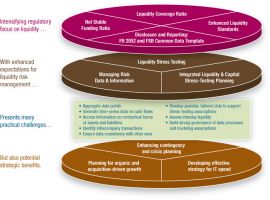Liquidity risk management rises in priority
Attention to large-bank issues will trickle down
- |
- Written by Promontory Financial Group, LLC

By Yoko Otani, Mark Levonian, and Stacy Coleman. This article is updated from Promontory Financial Group’s Sightlines publication.
U.S. and international regulators are moving forward with initiatives that will require financial institutions to reconsider how they manage liquidity risk. U.S. regulators, in particular, have moved aggressively to implement new rules and to tighten supervisory expectations in ways that will compel banking companies to address fundamental aspects of liquidity risk management, including stress testing, integration with capital planning, and data collection.
Multiple elements at play
The Office of the Comptroller of the Currency’s Jan. 16 proposal on heightened expectations for large banks covers the most recent element of the emerging regulatory regime for liquidity risk management. The proposal sets forth new standards for large banks in the design and implementation of overall risk governance frameworks that must explicitly incorporate liquidity risk. [For ABA’s joint comment letter with other associations on this proposal, click here.]
Another element is the liquidity coverage ratio (LCR) put forth last fall by the OCC, the Federal Reserve System, and FDIC—a ratio that is more stringent in various respects than that finalized in January 2013 by the Basel Committee on Banking Supervision (see these links: a and b.) The proposed U.S. LCR places greater limitations on high-quality liquid assets than the Basel III LCR, and uses more conservative assumptions about cash outflows and asset and liability inflows.
The U.S. proposal leaves unanswered some key questions, and hammering out the final rule is likely to take well into this year. In addition to requiring compliance by most large banking companies in the United States, the proposal would also apply to the U.S. subsidiaries of many foreign banking organizations and nonbank financial companies designated by the Financial Stability Oversight Council for Federal Reserve supervision.
The Basel committee in January released a revised proposal on the net stable funding ratio, which it said was an essential component of the Basel III reforms. The committee had included its initial net stable funding ratio proposal in the December 2010 Basel III agreement.
The LCR and upcoming OCC proposed requirements should not be viewed as narrow compliance exercises, but as pieces of the evolving regulatory agenda designed to promote stronger bank resilience—with liquidity a key consideration.
The emphasis on liquidity has reached beyond institutions explicitly covered by the U.S. LCR proposal, and is resulting in tighter monitoring of asset and liability profiles and liquidity risk management practices throughout the financial sector. The Federal Reserve’s liquidity monitoring reports (FR 2052a and b) are already requiring firms, including some organizations not subject to the LCR requirements, to collect and report detailed quantitative information on selected assets, liabilities, funding activities, and contingent liabilities.
Banks can expect further guidance from U.S. regulators on other important matters related to liquidity risk management, including the U.S. implementation of the net stable funding ratios and the leverage ratio under the Basel III framework, monitoring tools for intraday liquidity management, and additional reporting and qualitative and quantitative disclosure standards.
Coming expectations for banks
Firms are likely to feel the pressure of enhanced expectations for liquidity risk management in three areas:
• Liquidity stress testing.
• Integration of capital and liquidity stress testing and planning.
• Timely collection of accurate and granular data and information.
Firms will be able to better develop an effective strategy to address these expectations by:
• Taking a holistic approach that requires interpreting how enhanced regulatory expectations will affect various disciplines throughout the firm.
• Establishing appropriate governance and controls.
• Planning targeted information-technology upgrades.
Firms that proactively develop liquidity risk management programs linked to enterprise risk management will benefit from information and reporting that more clearly illuminate key business and risk drivers. These firms will be better prepared to address emerging risk issues, business opportunities, and regulatory expectations as they continue to evolve.
Liquidity stress testing
U.S. regulators have moved forward with requirements for liquidity stress testing that are likely to place increasing demands on banks. The Federal Reserve in 2012 proposed enhanced liquidity standards that included requirements for liquidity stress tests and contingency funding plans, along with requirements for corporate governance and independent review.
The proposed standards built on a March 2010 interagency policy statement that included expectations for cash-flow projections, liquidity stress tests, and contingency funding plans, along with other components of strong liquidity risk management programs.
Although these are not new concepts or practices, regulatory expectations are clearly moving in the direction of more in-depth quantitative analysis and enhanced approaches to stress testing and incorporation of the results into the firm’s risk and business practices.
The Federal Reserve in late 2012 initiated the Comprehensive Liquidity Analysis and Reviews for the very largest U.S. banking organizations in an undertaking similar to the Comprehensive Capital Analysis and Review. The CLAR requirements are having a trickle-down impact on supervisory reviews of firms, and enhanced expectations for stress testing are an element of the review of recovery and resolution plans.
As banks prepare for rigorous liquidity stress testing, regulators will continue to raise the bar. Firms should expect heightened supervisory expectations to include:
• Granular data and detailed analysis to support assumptions based on a company’s business model, product mix, and customer characteristics.
• Incorporation of secondary or systemic impacts as a result of actions a firm may take.
• More focus on intraday liquidity needs and associated risks.
• Strong governance practices in the use of applicable data and information, including the development of key modeling assumptions that are subject to approval by senior management and the board of directors.
Integrating capital and liquidity stress testing and planning
Although supervisors and the financial industry conceptually agree that capital and liquidity stress testing and planning should be integrated, the modeling and other practical challenges have been substantial. Notwithstanding the challenges, supervisory interest in the topic is clear, and regulators have signaled they intend to make such expectations explicit.
The Basel committee in October issued a working paper on liquidity stress testing that said separate assessments of capital and liquidity risks do not take proper account of their interaction, potentially resulting in an understated view of the company’s overall risk. Federal Reserve Board Governor Daniel Tarullo and other officials have articulated concerns regarding liquidity-related systemic risk, particularly with regard to short-term wholesale funding strategies, with implications for linkages between liquidity and capital risk planning. (See these two links—a and b—containing statements by Tarullo.)
Capital and liquidity are linked both conceptually and empirically, and stresses on either can lead to a damaging spiral in a crisis: Banks with impaired capital face higher funding costs and decreased access to funding sources, and higher funding costs deplete capital. (Read Promontory’s “Moving Beyond Regulatory Compliance In Stress Testing.”)
Integrated capital and liquidity planning and analysis will better inform ongoing business planning and strategy, including new-product assessment, portfolio rebalancing, contingency and crisis planning, and organic or acquisition-driven growth.
By aligning scenarios and core assumptions such as economic variables and interest rate projections, banks can achieve some consistency across stress tests, notwithstanding the technical difficulties of explicitly linking liquidity and capital stress testing. Banks can also rationalize the data-collection process for these disciplines, reducing duplicative efforts, improving quality and governance, and easing IT burden and cost.
Managing risk data and information
Regulators continue to push banking organizations to improve how they collect and use risk data and information, including for risk measurement and reporting purposes.
Dodd-Frank Act compliance has also added to data-collection demands, while the Basel Committee’s LCR disclosures and the Financial Stability Board’s phased introduction of the common data template could significantly increase data reporting burdens—especially for global systemically important banks and other large internationally active banks. The data is frequently similar, even when gathered and used for different purposes. Data requirements may overlap but not fully align, and differing uses will influence the design of data and systems.
For example, calculating the proposed LCR is likely to present data and information challenges for many firms, including:
• Collecting and aggregating granular data for a wide variety of assets and liabilities, and by counterparties or currencies
• Generating historic time-series data for inflows and outflows associated with many types of assets and liabilities
• Accessing and using information relating to the contractual terms of assets and liabilities and to the transferability across jurisdictions that some LCR calculations require
• Identifying and excluding intracompany transactions, including transactions between subsidiaries
• Ensuring consistency in the data and information used for the LCR calculation with those used for other risk management and business reporting purposes.
Banks will face many of these same challenges in calculating the net stable funding ratio and complying with the reporting requirements of the Federal Reserve’s new FR 2052, which builds on existing liquidity reporting but adds new requirements and covers additional organizations.
The challenge is for firms to address data requirements within an integrated strategic framework and architecture. Critical liquidity data and information are frequently spread throughout multiple IT platforms and may not be defined consistently, making it difficult to compile or aggregate data.
Many constituencies throughout the company may have an interest in the data, but it is often unclear who owns the data and who should manage it for risk purposes. Employees with the technical knowledge to access systems frequently lack a substantive understanding of the data and information that they are compiling.
Looking ahead
Addressing evolving requirements in liquidity risk management will be challenging and will compete with other demands for firm resources. However, by addressing specific requirements through a cohesive approach to managing risk, firms will be better positioned to deploy the necessary resources and realize strategic benefits—in addition to meeting regulatory expectations.
• • •
The Intensifying Focus On Liquidity Risk Management
Intensifying regulatory focus on liquidity, with enhanced expectations for liquidity risk management, presents many practical challenges, but also potential strategic benefits. Essential steps include:
• Generate time-series data on cash flows
• Access information on contractual terms of assets and liabilities
• Identify intracompany transactions
• Ensure data consistency with other uses
• Develop granular, tailored data to support stress-testing assumptions
• Assess intraday liquidity
• Build strong governance of data processes and modeling assumptions
About the authors
Yoko Otani is a managing director at Promontory and advises clients on risk and compliance matters, including asset-liability and liquidity risk management issues. Mark Levonian is the firm’s global head for enterprise economics and risk analysis, and assists clients with quantitative strategy and compliance matters, including risk quantification, model validation, stress testing, liquidity standards, and capital planning. Stacy Coleman is a director at Promontory, and assists clients on a variety of regulatory and supervisory issues, drawing on her expertise in policy analysis, development, and implementation.
Damon Palmer and Eric Schwartz contributed to this article.
Tagged under Management, Duties, Risk Management, HowTo, Operational Risk,














